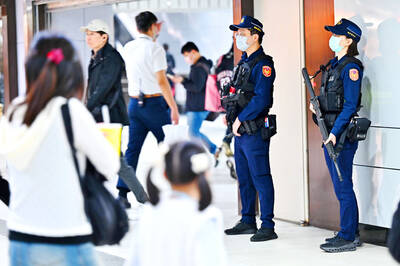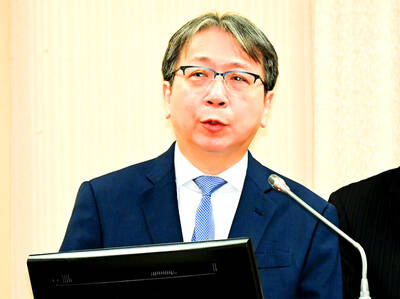The Taipei 228 Memorial Museum is reopening its doors to the public this morning after a 10-month renovation, but its efforts to reveal the truth of the 228 Incident met with challenges as pro--independence activists and family members of the incident’s victims yesterday accused the museum of glorifying the acts of the then-government and distorting the truth with its selection of documents.
The renovated interior design and the documents on display in the permanent exhibition, they said, turned the museum into a bright and beautiful hall that reflected little of the tragic event, and described the then-Chinese Nationalist Party (KMT) regime’s bloody crackdown on demonstrators in 1947 as the government’s exercise of authority.
“My grandfather disappeared shortly after participating in the investigation of the 228 Incident and asking the then-KMT government to stop killing innocent civilians. However, the exhibition said the then-government was trying to restore public order. I am stunned by such an interpretation of history,” said Lee Te-cheng (李德振), whose grandfather’s body was never found after he disappeared.
Touring the museum, Democratic Progressive Party (DPP) Taipei City Councilor Chien Yu-yen (簡余晏), former Academia Historica president Chang Yen-hsien (張炎憲) and former Taipei 228 Memorial Museum director Yeh Po-wen (葉博文) joined Lee in challenging the museum and the Taipei City Government, saying the government had demonstrated arrogance with its interpretation of history and had disrespected the victims and their families.
“What can our children learn about the tragic 228 Incident when all they see is a beautiful room filled with music, great photos of [former dictator] Chiang Kai-shek (蔣介石) and documents that portray the demonstrators as mobs?” Chien said.
Chang said the museum displayed an official order from -Chiang from March 1947 that banned military from taking any revenge measures against civilians following the 228 Incident. However, two other valuable historical documents that showed Chiang ordering then-Taiwan governor Chen Yi (陳儀) to lead troops to Taiwan to handle the accident were not on display.
Yeh said the exhibition also failed to show the exact number of victims of the 228 Incident and failed to discuss Chiang’s responsibility and urged the museum to delay its reopening ceremony and rearrange its exhibit.
Hsieh Ying-tseng (謝英從), director of the Taipei 228 Memorial Museum, yesterday said the museum had included more documents in its exhibition after Chang and other family members of the 228 Incident victims made suggestions.
“The exhibition objectively shows how the incident happened, the then-government’s handling and the victims and their family members’ reactions via historical documents. We do not make any interpretations and we respect different voices,” he said.
According to Hsieh, the museum began the discussion about updating the exhibition in 2007, and invited history experts including National Chengchi University history professor Chen Fang-ming (陳芳明) and Hsu Hsueh-chi (許雪姬), head of Academia Historica’s Institute of Modern History, to discuss the contents of the exhibition.
The museum also held a three-month preview exhibition in 2009 to collect opinions on the exhibition, before closing the museum in April last year for renovation, he said.
President Ma Ying-jeou (馬英九) will attend the reopening ceremony of the museum at 10am today. The museum will be open daily from 10am to 5pm and be closed on Mondays.
The 228 Incident refers to the KMT’s bloody crackdown on demonstrators under Chiang’s administration in 1947 after a woman was beaten for selling contraband cigarettes in Taipei on the night of Feb. 27, 1947.
The beating sparked nationwide disorder and the slaughter of tens of thousands of Taiwanese at the hands of KMT troops.
The KMT did not acknowledge the past mistakes nor offer public apologies over the incident until former president Lee Teng-hui’s (李登輝) administration. Ma has promised to make more effort to uncover the truth of the incident since taking office, and a national museum on the 228 Incident is scheduled to open on Feb. 28 in Taipei.

The US government has signed defense cooperation agreements with Japan and the Philippines to boost the deterrence capabilities of countries in the first island chain, a report by the National Security Bureau (NSB) showed. The main countries on the first island chain include the two nations and Taiwan. The bureau is to present the report at a meeting of the legislature’s Foreign Affairs and National Defense Committee tomorrow. The US military has deployed Typhon missile systems to Japan’s Yamaguchi Prefecture and Zambales province in the Philippines during their joint military exercises. It has also installed NMESIS anti-ship systems in Japan’s Okinawa

TRAGEDY STRIKES TAIPEI: The suspect died after falling off a building after he threw smoke grenades into Taipei Main Station and went on a killing spree in Zhongshan A 27-year-old suspect allegedly threw smoke grenades in Taipei Main Station and then proceeded to Zhongshan MRT Station in a random killing spree that resulted in the death of the suspect and two other civilians, and seven injured, including one in critical condition, as of press time last night. The suspect, identified as a man surnamed Chang Wen (張文), allegedly began the attack at Taipei Main Station, the Taipei Fire Department said, adding that it received a report at 5:24pm that smoke grenades had been thrown in the station. One man in his 50s was rushed to hospital after a cardiac arrest

PUBLIC SAFETY: The premier said that security would be tightened in transport hubs, while President Lai commended the public for their bravery The government is to deploy more police, including rapid response units, in crowded public areas to ensure a swift response to any threats, President William Lai (賴清德) said yesterday after a knife attack killed three people and injured 11 in Taipei the previous day. Lai made the remarks following a briefing by the National Police Agency on the progress of the investigation, saying that the attack underscored the importance of cooperation in public security between the central and local governments. The attack unfolded in the early evening on Friday around Taipei Main Station’s M7 exit and later near the Taipei MRT’s Zhongshan

ON ALERT: Taiwan’s partners would issue warnings if China attempted to use Interpol to target Taiwanese, and the global body has mechanisms to prevent it, an official said China has stationed two to four people specializing in Taiwan affairs at its embassies in several democratic countries to monitor and harass Taiwanese, actions that the host nations would not tolerate, National Security Bureau (NSB) Director-General Tsai Ming-yen (蔡明彥) said yesterday. Tsai made the comments at a meeting of the legislature’s Foreign Affairs and National Defense Committee, which asked him and Minister of National Defense Wellington Koo (顧立雄) to report on potential conflicts in the Taiwan Strait and military preparedness. Democratic Progressive Party (DPP) Legislator Michelle Lin (林楚茵) expressed concern that Beijing has posted personnel from China’s Taiwan Affairs Office to its